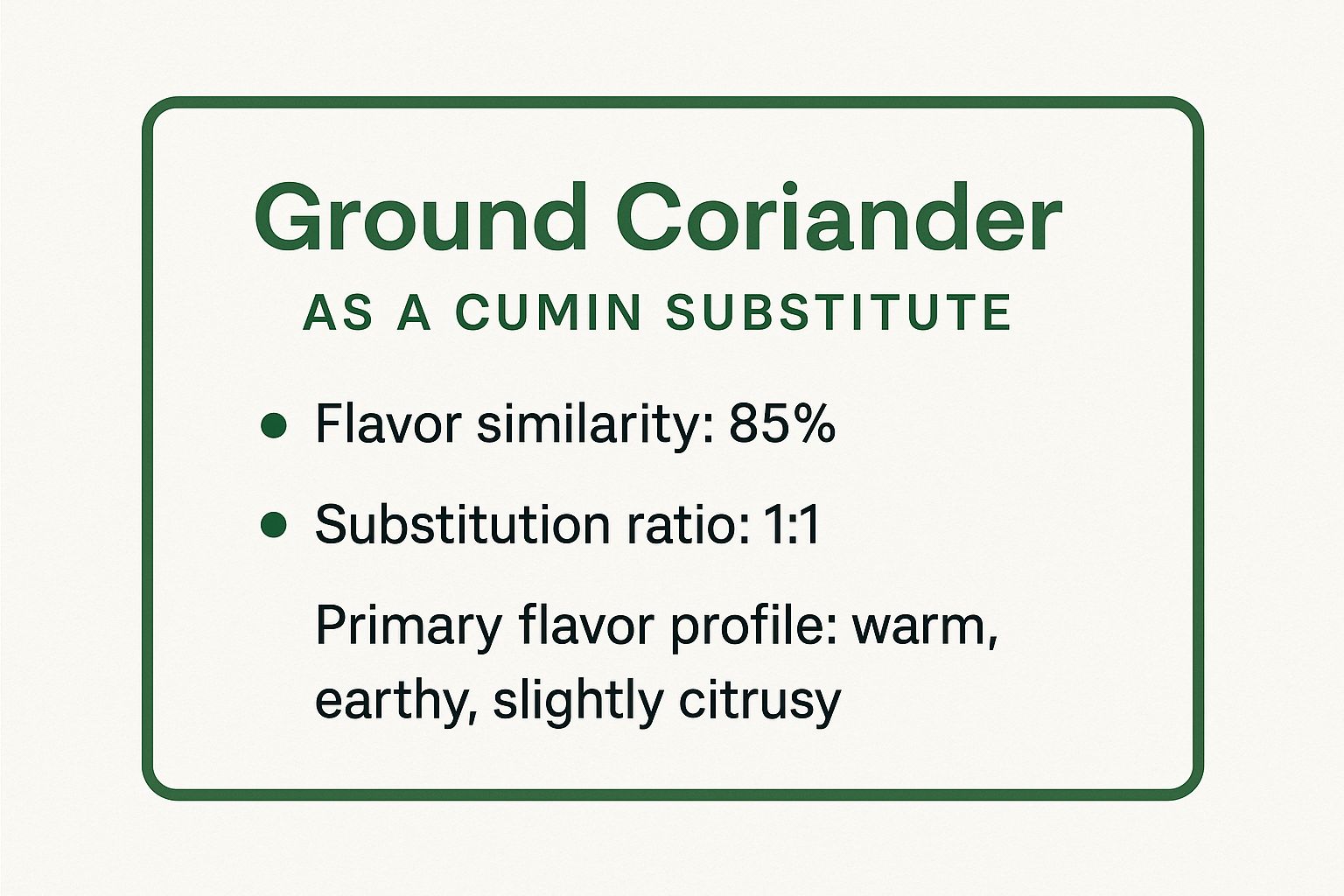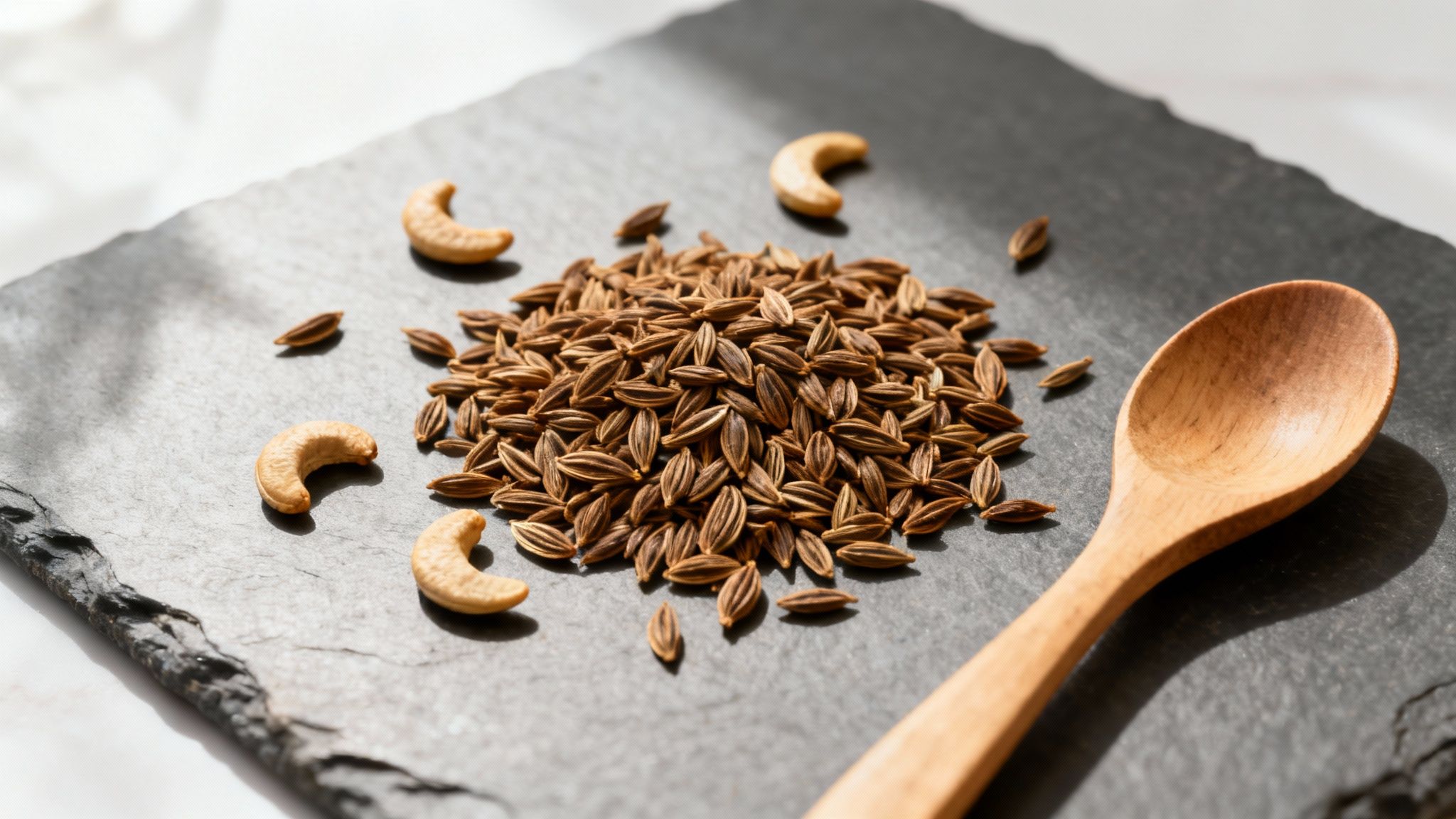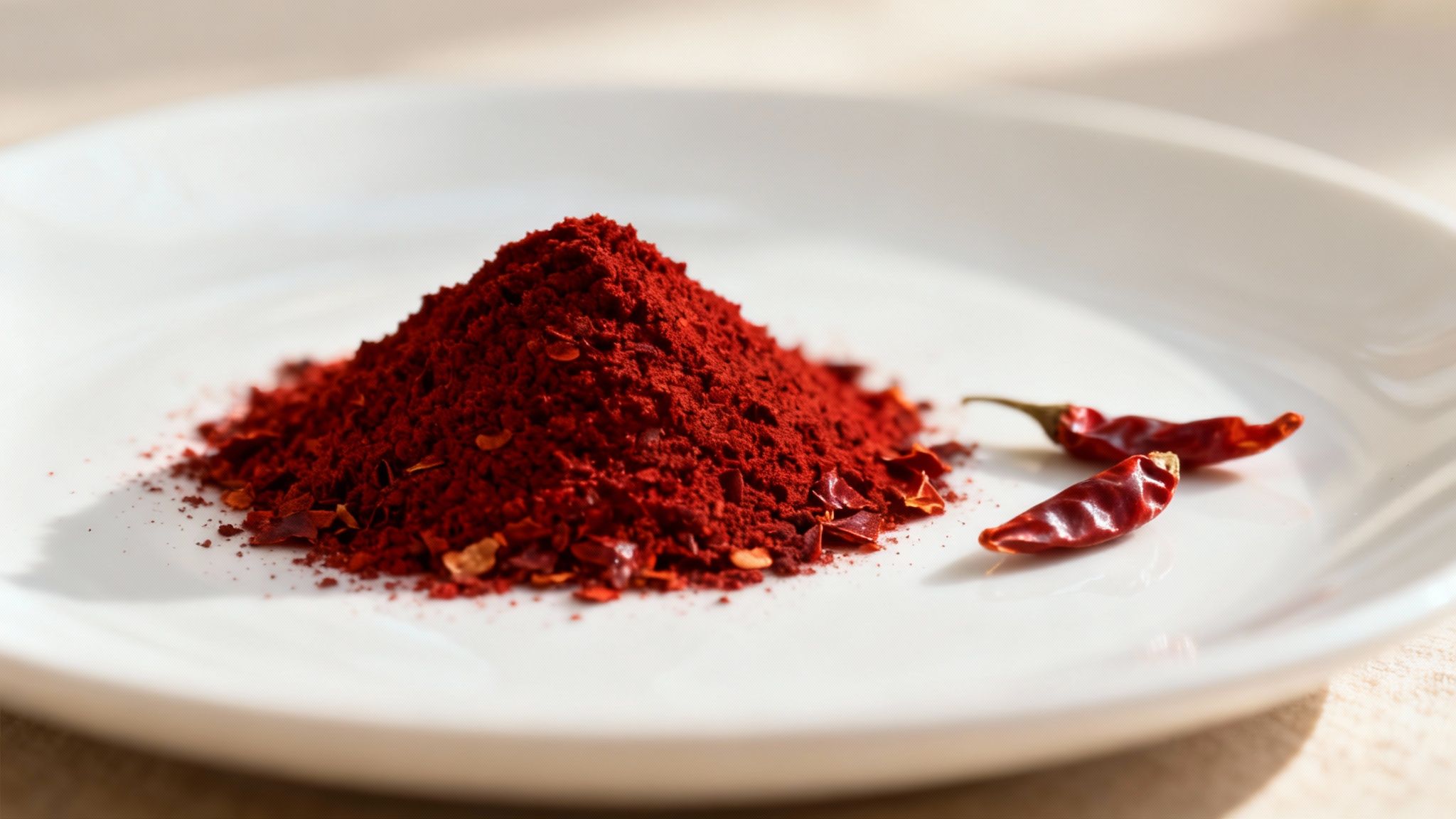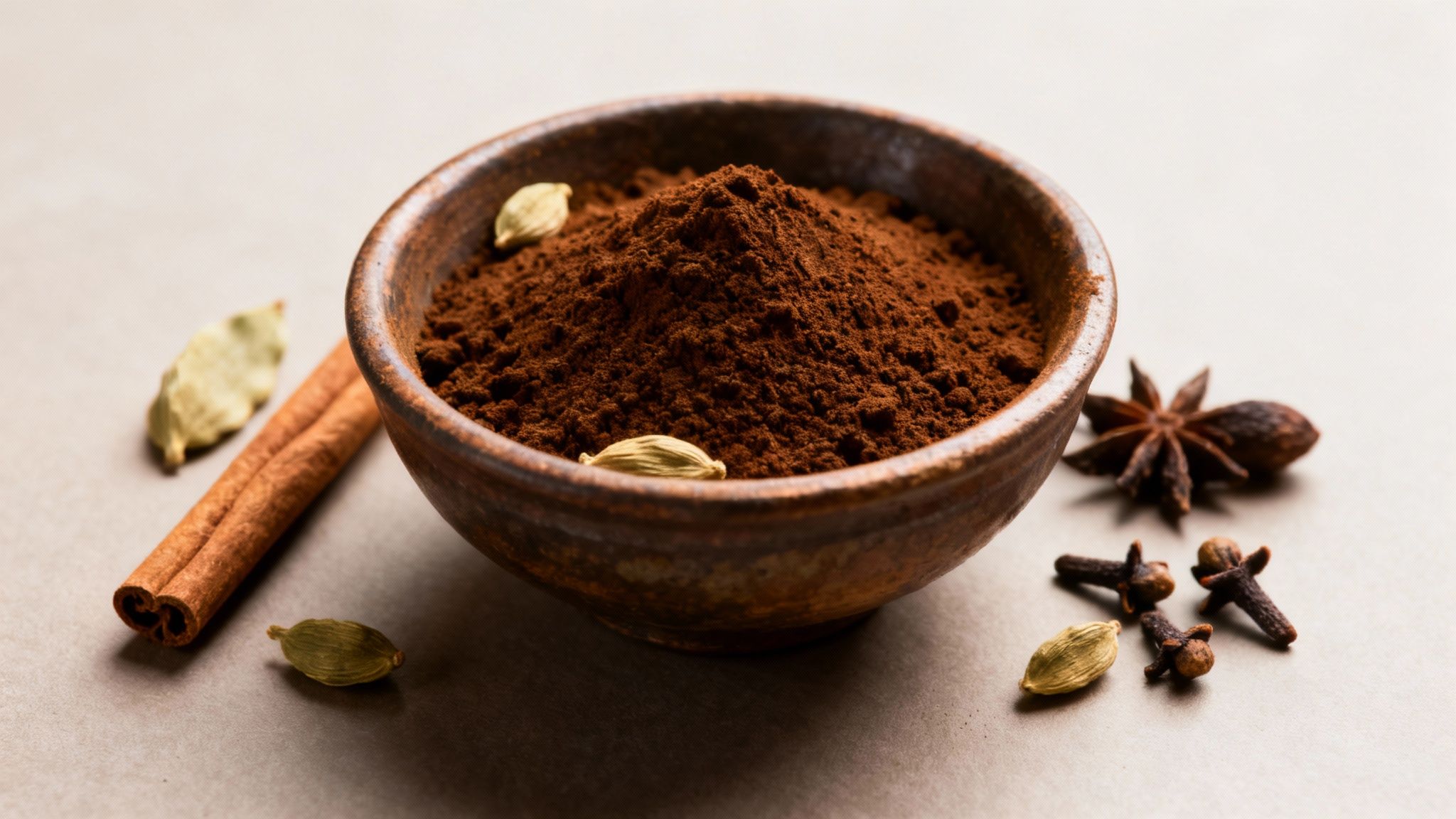7 Best Cumin Spice Substitute Options for Any Recipe (2025)
Imagine this: you’re halfway through preparing a flavorful chili or a fragrant curry, you reach for that essential jar of cumin, and… it’s empty. This common kitchen dilemma can send a wave of panic, but it doesn’t have to derail your dinner. Cumin, with its distinctively warm, earthy, and slightly smoky flavor, is a powerhouse spice in cuisines from Mexico to Morocco. Its unique profile can seem irreplaceable, but your pantry likely holds a variety of excellent alternatives that can save your dish.
Understanding which spice to use, and how much, is the key to turning a culinary crisis into a creative opportunity. This is a fundamental skill, much like knowing how to convert recipes for different serving sizes or dietary needs. Mastering substitutions empowers you to be more flexible and resourceful in the kitchen.
This guide will walk you through the seven best cumin spice substitutes, detailing their flavor profiles, ideal substitution ratios, and pro tips to ensure your meal is just as delicious as you intended. We will explore everything from the closest botanical relatives like coriander to complex spice blends such as garam masala. Our goal is to give you the confidence to adapt and improvise like a seasoned chef, ensuring that an empty spice jar is never a reason to abandon a great meal.
1. Ground Coriander
When you find your spice rack missing its most essential earthy component, ground coriander is the first substitute you should reach for. Derived from the dried seeds of the cilantro plant, coriander is a botanical cousin to cumin. This familial connection results in a remarkably similar flavor base, making it an excellent cumin spice substitute in a pinch.
Both spices share a warm, earthy, and slightly nutty profile. However, coriander introduces a brighter, more citrusy, and slightly sweeter note that distinguishes it from cumin’s deeper, smokier character. Because they are so frequently used together in spice blends across the globe, from Indian garam masala to Middle Eastern baharat, your palate is likely already accustomed to their combined flavor.
How to Use Ground Coriander as a Cumin Substitute
The substitution process is straightforward, but a few adjustments can help you mimic cumin’s signature taste more accurately. For most recipes, you can begin with a simple one-to-one ratio.
- Substitution Ratio: Start by replacing every 1 teaspoon of ground cumin with 1 teaspoon of ground coriander.
- Best For: This substitute shines in cooked dishes like curries, soups, and stews where flavors have time to meld. It’s particularly effective in Indian, Mexican, and Middle Eastern cuisines.
- Flavor Enhancement: To deepen the flavor and compensate for cumin’s characteristic warmth, consider adding a pinch of chili powder or smoked paprika. Toasting the ground coriander in a dry pan for 30-60 seconds before use also amplifies its nutty, earthy notes.
The infographic below summarizes the key data points for using ground coriander as a quick-reference guide.

As the data highlights, the 85% flavor similarity and direct 1:1 ratio make ground coriander a reliable and easy-to-implement option for almost any recipe.
For a deeper dive into the relationship between these two essential spices and how their flavors interact, the following video provides an excellent visual explanation.
Ultimately, ground coriander is the top cumin substitute due to its accessibility and close flavor profile, ensuring your dish maintains its intended culinary direction without a drastic departure in taste.
2. Caraway Seeds
For a substitute that offers a distinct yet complementary flavor, caraway seeds are a fantastic option. These small, crescent-shaped seeds, famous for their role in rye bread and sauerkraut, share cumin’s earthy and slightly peppery notes. While caraway introduces a subtle anise or licorice-like flavor, its underlying warmth makes it an effective cumin spice substitute, particularly in robust, savory dishes.

Originating from Europe and Western Asia, caraway has a bold profile that can stand up to hearty ingredients. Its aromatic qualities work well in dishes where cumin’s earthiness is desired, such as stews, cabbage-based recipes, and even some chili variations. Using whole seeds and grinding them fresh can also help you manage food waste by extending their shelf life, a key principle you can learn more about in these food waste reduction strategies.
How to Use Caraway Seeds as a Cumin Substitute
Because caraway has a stronger, more assertive flavor than cumin, the substitution requires a bit of adjustment. A direct one-to-one replacement might overwhelm your dish, so it’s best to start with a smaller amount and build from there.
- Substitution Ratio: Begin by using half the amount of caraway seeds for the ground cumin called for in your recipe. For every 1 teaspoon of ground cumin, use ½ teaspoon of ground caraway seeds. You can add more to taste.
- Best For: This substitute excels in hearty European and North African dishes. It works beautifully in rich stews, roasted root vegetables, potato salads, and savory baked goods like Irish soda bread.
- Flavor Enhancement: To better replicate cumin’s profile, toast the whole caraway seeds in a dry pan for about a minute before grinding. This process mellows the licorice notes and enhances the nutty, earthy undertones. For an even closer match, combine the ground caraway with an equal part of ground coriander.
While it has a unique character, caraway’s earthy depth ensures it can fill the void left by cumin without completely altering the dish’s intended flavor. Its bold nature makes it a confident and reliable stand-in when you need that warm, aromatic punch.
3. Chili Powder
When your recipe calls for cumin’s earthy depth, especially in a dish with a bit of a kick, chili powder is an excellent and readily available solution. Chili powder is not a single spice but a versatile blend. It typically features ground chili peppers as its base, combined with other spices like garlic powder, oregano, and, most importantly, cumin itself. This built-in cumin content makes it a natural cumin spice substitute.
The presence of cumin in the blend means you’re not just masking its absence; you’re adding it back in, along with complementary flavors. This makes chili powder a particularly fitting choice for Mexican, Tex-Mex, and Southwestern dishes where these spice profiles are already celebrated. The added chili element introduces a mild heat and reddish hue that can enhance recipes like taco meat, enchilada sauces, and hearty chilis.

How to Use Chili Powder as a Cumin Substitute
Using a spice blend requires a slightly different approach than a single-ingredient substitute. The key is to start with less and adjust, as the heat and flavor intensity can vary significantly between brands.
- Substitution Ratio: Begin by using half the amount of chili powder for the cumin required. For every 1 teaspoon of cumin, start with ½ teaspoon of chili powder.
- Best For: This substitute is ideal for Mexican, Latin American, and spicy dishes. It works perfectly in chili con carne, taco fillings, dry rubs for grilled meats, and Mexican rice.
- Flavor Enhancement: Since chili powder formulations differ, always taste as you go. If your dish can handle more heat, you can increase the amount to get closer to the desired cumin flavor. For a less spicy option, seek out a “mild” chili powder blend, which will allow the cumin notes to come through more prominently without overwhelming the dish with heat. Always check the ingredient label to understand the blend’s composition.
4. Garam Masala
For an instant boost of complex, warming flavor, garam masala is a fantastic cumin spice substitute, especially in South Asian cuisine. This aromatic blend, whose name translates to “hot spice mixture,” originates from the Indian subcontinent and is a cornerstone of many regional dishes. Because nearly all traditional garam masala recipes include cumin as a key ingredient, you are already getting the flavor you need, plus a symphony of other complementary spices.
The exact composition of garam masala varies, but it commonly features coriander, cardamom, cinnamon, cloves, and black pepper alongside cumin. This means that while it provides the essential earthy notes, it also introduces a sweet, pungent, and slightly floral complexity that can elevate a dish. This pre-existing blend makes it a convenient and deeply flavorful alternative.

How to Use Garam Masala as a Cumin Substitute
Using a spice blend requires a more nuanced approach than a single-ingredient swap. Since garam masala is potent and contains other strong flavors, you’ll need to adjust the quantity to avoid overpowering your dish.
- Substitution Ratio: Start by using half the amount of garam masala. For every 1 teaspoon of cumin called for, use ½ teaspoon of garam masala. You can adjust to taste from there.
- Best For: It excels in Indian curries, lentil soups (dal), and roasted vegetable preparations. It can also add a unique twist to Middle Eastern meat dishes or hearty stews.
- Flavor Enhancement: To preserve its fragrant and volatile oils, it is often best to add garam masala toward the end of the cooking process. For dishes that need a deeper, less aromatic profile, you can add it earlier with other spices. The warming properties of this blend are perfect for winter meals; you can explore additional ways to incorporate warming spices into your cooking for more ideas.
Ultimately, reaching for garam masala not only solves the problem of missing cumin but also introduces an authentic, layered complexity that can make your final dish even more memorable.
5. Curry Powder
When looking for a quick and flavorful fix, curry powder can serve as a surprisingly effective cumin spice substitute. This widely available blend was originally a British invention designed to capture the essence of Indian cooking. Since most curry powders feature cumin as a primary ingredient alongside coriander and turmeric, they inherently provide the earthy base notes you’re trying to replace.
The key difference is that curry powder is a composite spice, not a singular one. It brings a host of other flavors to the party, including the bright yellow hue from turmeric, the slight bitterness of fenugreek, and the warmth of ginger or chili. This makes it a multi-dimensional substitute that can add unexpected but often welcome complexity to a dish.
How to Use Curry Powder as a Cumin Substitute
Using a spice blend requires a more nuanced approach than a single-ingredient substitute. The goal is to leverage its cumin content without letting the other flavors overwhelm your recipe’s original intent. While exploring different spice blends, you might also be interested in the individual aromatic components, such as the fragrant Curry Leaf, often foundational to dishes using curry powder.
- Substitution Ratio: Start by using half the amount of curry powder. For every 1 teaspoon of ground cumin, use ½ teaspoon of curry powder. You can adjust upwards after tasting.
- Best For: This substitute excels in dishes that are already warm and savory, such as lentil soups, roasted vegetable dishes, and certain stews or marinades where the additional spices will feel at home. It works well in curried deviled eggs or potato salads.
- Flavor Enhancement: Be mindful that curry powder will change the color of your dish to a yellowish tint due to the turmeric. If you desire more heat, opt for a “Madras” or hot curry powder blend. Avoid using it in cuisines like Mexican or traditional Latin American, where its distinct profile would feel out of place.
6. Ground Fennel Seeds
For a substitute that introduces an aromatic and slightly sweet complexity, ground fennel seeds are an unexpectedly effective choice. Derived from the flowering plant Foeniculum vulgare, fennel offers a distinct licorice-like flavor that, while different from cumin, shares a common warmth and earthiness. This makes it a creative and intriguing cumin spice substitute, especially in specific culinary contexts.
The primary difference lies in fennel’s sweet, anise-like notes, which stand in contrast to cumin’s smoky, slightly bitter profile. However, this sweetness can beautifully complement certain dishes, particularly those in Mediterranean, Italian, and some Middle Eastern cuisines. Its unique aroma brings a fresh dimension to recipes, offering a sophisticated twist when cumin is unavailable.
How to Use Ground Fennel Seeds as a Cumin Substitute
Due to its potent and distinct flavor, using ground fennel requires a more measured approach than a simple one-to-one swap. Adjusting the ratio and pairing it with other spices is key to achieving a balanced result.
- Substitution Ratio: Start by using half the amount of ground fennel. For every 1 teaspoon of ground cumin, use 1/2 teaspoon of ground fennel seeds. You can add more to taste if needed.
- Best For: This substitute excels in Italian sausage recipes, pasta sauces, Mediterranean fish dishes, and roasted vegetable preparations. It also works well in recipes featuring tomatoes, as the acidity balances fennel’s inherent sweetness.
- Flavor Enhancement: To create a more cumin-like flavor, combine the ground fennel with an equal part of ground coriander. Toasting whole fennel seeds in a dry pan for a minute before grinding them will also deepen their warmth and reduce the intensity of the licorice notes, bringing them closer to cumin’s earthy character.
7. Taco Seasoning Mix
When you’re in the middle of preparing a Mexican or Tex-Mex dish and realize the cumin is gone, reaching for a packet of taco seasoning can be a quick and effective solution. This pre-blended mix is specifically designed for these cuisines, and cumin is almost always its star ingredient, often comprising up to 40% of the blend. This makes taco seasoning a highly convenient and flavorful cumin spice substitute in the right context.
Beyond cumin, taco seasoning typically includes chili powder, paprika, garlic powder, onion powder, and oregano. This combination provides the earthy depth of cumin while adding a complex, savory, and slightly spicy character that is already tailored for dishes like tacos, burritos, and fajitas. Because the flavors are pre-balanced, it integrates seamlessly into these specific culinary profiles.
How to Use Taco Seasoning Mix as a Cumin Substitute
Using a pre-made blend requires a bit of adjustment to account for the other ingredients, especially salt. The key is to use it judiciously and only in appropriate dishes to avoid overpowering other flavors or making the food too salty.
- Substitution Ratio: Start by using 1 ½ to 2 teaspoons of taco seasoning for every 1 teaspoon of ground cumin. Since it contains multiple spices, you’ll need more to achieve a similar cumin intensity.
- Best For: This substitute is tailor-made for Mexican, Tex-Mex, and Southwestern dishes. It works perfectly in ground beef for tacos, burrito bowls, quesadilla fillings, and Mexican-style rice dishes.
- Flavor Enhancement: Check the label for salt content. If your taco seasoning contains salt, you will need to reduce or even eliminate the salt called for elsewhere in the recipe. For a more tailored flavor profile in your dishes, you can explore making your own blend. For more ideas on how to use these flavors, check out these Mexican low-carb recipes.
The infographic below summarizes the key data points for using taco seasoning mix as a quick-reference guide.
As the data highlights, the 75% flavor similarity and adjusted ratio make taco seasoning a fantastic option when your dish aligns with its intended Tex-Mex flavor profile.
For a great example of how these flavors come together in a classic dish, the following video shows how to make perfect taco meat, where cumin is a key player.
Ultimately, while not a universal replacement, taco seasoning mix is an excellent, specialized cumin substitute that saves the day for any south-of-the-border-inspired meal.
7 Best Cumin Substitutes Comparison
| Substitute | Implementation Complexity 🔄 | Resource Requirements ⚡ | Expected Outcomes 📊 | Ideal Use Cases 💡 | Key Advantages ⭐ |
|---|---|---|---|---|---|
| Ground Coriander | Low 🔄 | Low ⚡ | Warm, earthy, slightly citrusy flavor; 85% cumin similarity | Indian, Middle Eastern, Latin American cuisine | Most similar flavor; easy 1:1 substitution |
| Caraway Seeds | Medium 🔄 | Medium ⚡ | Earthy, warm with licorice note; 70% cumin similarity | Hearty breads, stews, meat dishes | Adds complexity; good in robust dishes |
| Chili Powder | Low 🔄 | Low ⚡ | Complex, spicy blend including cumin; 60% similarity | Mexican, Tex-Mex, Southwestern | Contains cumin, adds warmth and depth |
| Garam Masala | Medium-High 🔄 | Medium-High ⚡ | Warm, complex spice blend; 65% cumin similarity | Indian, South Asian dishes | Authentic Indian flavor; includes cumin |
| Curry Powder | Low 🔄 | Low ⚡ | Complex with turmeric and cumin; 60% similarity | Indian-inspired, fusion dishes | Convenient all-in-one; adds color and flavor |
| Ground Fennel Seeds | Medium 🔄 | Low ⚡ | Sweet, aromatic with licorice notes; 50% cumin similarity | Italian, Mediterranean cuisine | Adds sweetness and warmth; versatile use |
| Taco Seasoning Mix | Low 🔄 | Low ⚡ | Cumin-dominant Mexican spice blend; 75% similarity | Mexican, Tex-Mex dishes exclusively | Ready-made, convenient; consistent cumin flavor |
Mastering Your Spice Rack: Beyond the Recipe
Navigating the spice cabinet can feel like a complex puzzle, especially when a core ingredient like cumin is missing. However, as we’ve explored, running out of cumin isn’t a kitchen catastrophe; it’s a creative opportunity waiting to be seized. The seven distinct substitutes detailed in this guide, from the citrusy warmth of ground coriander to the complex blend of garam masala, prove that adaptability is the most valuable tool a cook can possess.
The journey doesn’t end with simply finding a replacement. True culinary mastery comes from understanding why a substitute works. It’s about recognizing the earthy notes in caraway that mimic cumin, or appreciating how the smoky heat of chili powder can fill a similar role while adding a new dimension to your dish. Each substitute offers a lesson in flavor pairing and ingredient synergy.
Key Takeaways for Your Culinary Toolkit
Think of this guide as more than just a list; it’s a new framework for approaching your recipes. Instead of following instructions blindly, you are now equipped to make informed, creative decisions.
- For Earthy Warmth: Your best direct replacements are ground coriander and caraway seeds. Start with a 1:1 ratio for caraway and a slightly less potent 1/2 to 3/4 teaspoon for every teaspoon of cumin when using coriander. These are ideal for maintaining the foundational flavor profile in dishes like curries, stews, and soups.
- For Complex Spice Blends: When you need a cumin spice substitute that also contributes depth, turn to garam masala or curry powder. These blends already contain cumin, making them a natural fit. Remember to adjust other seasonings in your recipe, as these mixes introduce a symphony of other flavors like cinnamon, cloves, and turmeric.
- For a Bold, Smoky Kick:Chili powder and taco seasoning are your go-to options for Southwestern, Tex-Mex, and Mexican cuisines. They bring not just earthiness but also heat and savory notes from ingredients like paprika and oregano. This is less about a direct swap and more about a strategic flavor pivot.
Your Next Steps in the Kitchen
The next time you reach for the cumin and find the jar empty, don’t panic. Embrace the moment as a chance to experiment. Pull out this guide and choose a path. Will you opt for the subtle, nutty profile of ground fennel seeds in your next vegetable roast? Or will you infuse your chili with the robust, multi-layered warmth of a high-quality curry powder?
The most important step is to taste as you go. Add your chosen substitute incrementally, tasting after each addition to ensure the flavor balance is just right. This practice will sharpen your palate and build your confidence, transforming you from a recipe follower into a recipe creator. Your spice rack is no longer a static collection but a dynamic palette of possibilities.
Ready to elevate your culinary experiences without the stress of a missing ingredient? At Culinary Collective Atl, our private chefs master the art of adaptation and flavor to create unforgettable meals tailored to your exact tastes. Let us handle the complexities of the spice rack for you by booking a personalized dining experience at Culinary Collective Atl.





